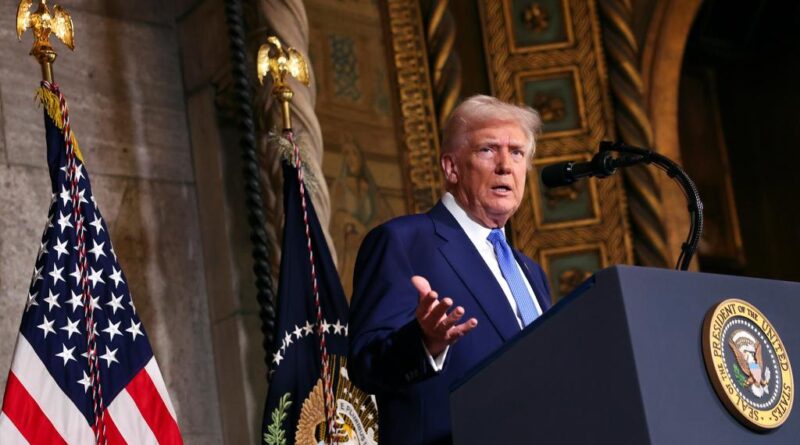Trump’s Era Exposes the Facade of Democracy in Washington’s Bureaucracy — A Call for Urgent Reform

Here’s a little-known truth about the federal government that many Americans are just beginning to realize: It is consistently managed by Democrats, even when Republicans are elected by voters.
While presidents come and go, the permanent federal bureaucracy remains constant, exhibiting a clear partisan bias.
When Americans elect a Republican president, they often find a government still mainly operated by members of the opposing party.
This situation undermines the essence of democracy.
Yet, no previous president before Donald Trump was willing to address this issue.
Due to the inherent bias present in the federal civilian workforce of over 2 million employees, leaders like Bill Clinton, Barack Obama, and Joe Biden were unlikely to rectify the situation.
In earlier times, when political parties were not as ideologically divided and there were numerous conservative Democrats and liberal Republicans, it was less apparent that the bureaucracy’s partisan bias contributed to a workforce that was at odds with the president when he wasn’t aligned with their party.
However, since Ronald Reagan’s presidency, it has become increasingly clear that a Republican who attempts to implement a conservative agenda may encounter resistance from within the ranks.
The Constitution’s separation of powers does not accommodate a division within the executive branch — this branch is intended to function cohesively while being externally checked.
Historically, the partisan configuration of the federal workforce was largely contingent upon who secured the presidency: Republicans employed Republicans, Democrats employed Democrats, and it was widely understood that federal employees risked losing their jobs with a party shift.
Both political factions viewed government positions as rewards for their supporters, regardless of qualifications.
A perceived solution to the inefficiencies and corrupt practices of this approach was the establishment of a nonpartisan, merit-based civil service.
However, like many well-intentioned reforms, this one backfired.
Rather than achieving a nonpartisan civil service, we are left with a system where partisanship no longer alternates with elections — resulting in a permanent liberal bureaucracy that is unaccountable to the electorate.
Guo Xu, an associate professor at the University of California, Berkeley’s Haas School of Business, has examined the extent and impact of partisanship in the federal workforce.
His analysis of data from 1997 to 2019 revealed that about half of all federal employees identified as Democrats (compared to 41% of the general public) while the percentage of Republicans in federal roles decreased from 32% to 26%, with independents filling the gap.
This reflects an almost two-to-one ratio of Democrats to Republicans within the civil service.
The disparity is even more significant in various departments and agencies, with Democrats constituting approximately 70% of employees in the Environmental Protection Agency, Department of Education, and State Department, according to Xu’s findings.
The bias is also more pronounced among high-ranking civil servants, with Democrats making up 63% of senior federal career executives.
Xu and his colleagues discovered that cost overruns on government contracts rise by roughly 8% when there is a partisan “misalignment” between the president and the bureaucrat in charge of the expenditure.
“When we analyzed HR surveys concerning federal government employees, we also noticed that politically misaligned respondents showed less motivation and were less inclined to identify with the overall mission of their agency,” Xu remarked in an interview on the BerkeleyHaas website.
Xu does not position himself as a conservative critic of the system — he interprets the lack of turnover in the federal workforce when party control of the presidency shifts as evidence that “civil service protections are effective, safeguarding career civil servants from political interference.”
In reality, civil servants with their own partisan biases are insulated from the outcomes of elections — as though the American populace has no right to “interfere” in their own government.
A recent report from the Foundation for Government Accountability validates Guo’s findings and broadens them, noting that “in the 2024 presidential election, 84% of federal employees’ political donations were directed to Kamala Harris.”
The consequence: When voters cast their ballots for a Democrat as president, they receive a Democratic administration — yet when they opt for a Republican, they are met with a hybrid administration that is hampered by partisan rifts among political appointees and the civil service.
This phenomenon is one reason why Republican attempts to downsize the federal government have been so fruitless over the years: Effectively, there have only been semi-Republican administrations for decades or a continuous Democratic administration with intermittent Republican leaders.
It is high time to reform the civil-service reforms that brought about this predicament.
There is merit in revisiting the successful practices of earlier reformers, such as utilizing standardized testing for hiring and promotions instead of relying on contemporary, highly politicized factors like “diversity, equity, and inclusion.”
Furthermore, it is essential to recognize that bureaucrats are also partisans.
President Trump’s initiative to reclassify a significant number of federal employees as Schedule F appointees, allowing him greater latitude to dismiss them, is a move towards increasing the accountability of the bureaucracy to the democratic process.
By addressing the partisan bias within the permanent government, Trump is not threatening the Constitution; rather, he is working to restore its equilibrium.
Daniel McCarthy is the editor of Modern Age: A Conservative Review and also serves as editor-at-large for The American Conservative.



